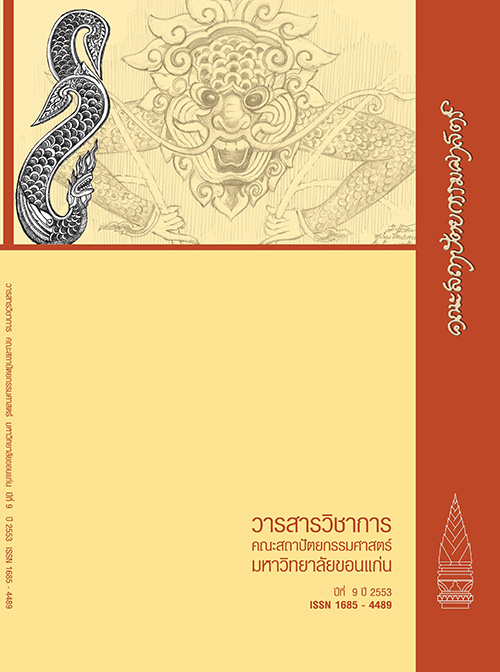การพัฒนาผนังอาคารจากวัสดุเหลือใช้เพื่อปรับปรุงสภาวะน่าสบายในอาคาร กรณีศึกษา: ภาคตะวันออกเฉียงเหนือ ประเทศไทย
คำสำคัญ:
สภาวะน่าสบาย, ผนังอาคาร, วัสดุเหลือใช้, วัสดุฉนวน, การวิจัยเชิงทดลอง, Human Thermal Comfort, Building Wall, Non-Using Materials, Insulations, Experimental Researchบทคัดย่อ
บทความนี้มีวัตถุประสงค์เพื่อค้นหาแนวทางของการประยุกต์ใช้วัสดุเหลือใช้เพื่อปรับปรุงสภาวะน่าสบายในอาคารของ ภาคตะวันออกเฉียงเหนือ โดยวัสดุที่นำมาทดสอบในการวิจัยนี้ได้แก่ วัสดุแกลบเหลือใช้ที่มีลักษณะเป็นโพรงอากาศภายในที่ ความหนาแน่น 3.2 ปอนด์ต่อลูกบาศก์ฟุต และกล่องบรรจุภัณฑ์นมเหลือใช้ที่มีลักษณะเป็นช่องว่างอากาศภายในที่มีอลูมินั่ม ฟอยล์อยู่ภายใน ทำการทดสอบโดยการจัดสร้างเซลทดสอบจากโฟมโพลีสไตรีนหนา 6 นิ้ว มีการติดตั้งผนังทดสอบสามรูปแบบ ได้แก่ ผนังก่ออิฐฉาบปูนปกติ ผนังก่ออิฐฉาบปูนที่มีกล่องบรรจุภัณฑ์นมติดตั้งอยู่ภายใน และผนังก่ออิฐฉาบปูนที่มีกล่องบรรจุ ภัณฑ์นมบรรจุแกลบติดตั้งอยู่ภายใน โดยการหันผนังทดสอบไปทางทิศใต้ที่ได้รับแสงอาทิตย์ตลอดวัน เก็บข้อมูลโดยใช้เครื่อง วัดอุณหภูมิ Fluke Hydra Logger วัดอุณหภูมิอากาศ อุณหภูมิผิวภายนอก อุณหภูมิผิวภายใน และอุณหภูมิภายในเซลทดสอบ ผลการทดสอบแสดงให้เห็นว่า ในเวลากลางวันผลต่างของอุณหภูมิโดยเฉลี่ยภายในเซลทดสอบผนังก่ออิฐฉาบปูนที่มีฉนวน กล่องนมบรรจุแกลบติดตั้งอยู่ภายใน กับอุณหภูมิภายในเซลทดสอบผนังก่ออิฐฉาบปูนปกติมีค่าประมาณ 2.5-3 องศาเซลเซียส ในขณะที่ผลต่างของอุณหภูมิโดยเฉลี่ยภายในเซลทดสอบผนังก่ออิฐฉาบปูนที่มีฉนวนกล่องนมติดตั้งอยู่ภายใน กับอุณหภูมิ ภายในเซลทดสอบผนังก่ออิฐฉาบปูนปกติมีค่าประมาณ 1.5-2 องศาเซลเซียส สามารถสรุปได้ว่าการใช้ฉนวนกล่องนม และฉนวน กล่องนมบรรจุแกลบในการติดตั้งร่วมกับผนังก่ออิฐฉาบปูนนั้น ทำให้อุณหภูมิอากาศภายในเข้าใกล้สภาวะน่าสบายมากยิ่งขึ้น ทั้งนี้เนื่องจากคุณสมบัติความเป็นฉนวนของวัสดุแกลบที่มีลักษณะเป็นโพรงอากาศภายใน และคุณสมบัติความเป็นฉนวนของ ช่องว่างอากาศสะท้อนรังสีของกล่องบรรจุภัณฑ์นม
A Development of Building Thermal Wall from Non-Using Materials to Improve Thermal Comfort in Building. Case Study: Northeastern Region, Thailand
The objectives of research are searching for the alternative materials and knowing their application of nonusing materials to improve thermal comfort in building of Northeastern region of Thailand. The materials of this research were rice husk which has 3.2 lb/ft3 density and milk containers that has a reflective air space because of aluminum foil inside. The test cells were built to collect the data by Polystyrene foam 6 inches thick and the three test walls are: 4-inches brick wall, 4-inches brick wall with milk containers insulated inside, and 4-inches brick wall with milk containers and rice husk insulated inside. These test walls were faced south to get the direct sun from this direction. Fluke Hydra Logger was used to collect the air temperatures, outside surface temperatures, inside surface temperatures, and test cell temperatures. The result shows, the average temperature difference between 4-inches brick wall with milk container and rice husk insulated inside and 4-inche brick wall is 2.5-3 degree Celsius in daytime. The average temperature difference between 4-inche brick wall with milk container insulated inside and 4-inches brick wall is 1.5-2.0 degree Celsius in daytime. The conclusion is the application of milk container and milk container with rice husk inside in 4-inche brick wall can reduce the harsh of temperature especially in daytime. The temperature inside the test cell is nearly in the range of human comfort zone because of the thermal resistance of the cavities in rice husk and the reflective air spaces of milk container
ดาวน์โหลด
รูปแบบการอ้างอิง
ฉบับ
ประเภทบทความ
สัญญาอนุญาต
ทัศนะและข้อคิดเห็นของบทความที่ปรากฏในวารสารฉบับนี้เป็นของผู้เขียนแต่ละท่าน ไม่ถือว่าเป็นทัศนะและความรับผิดชอบของกองบรรณาธิการ




